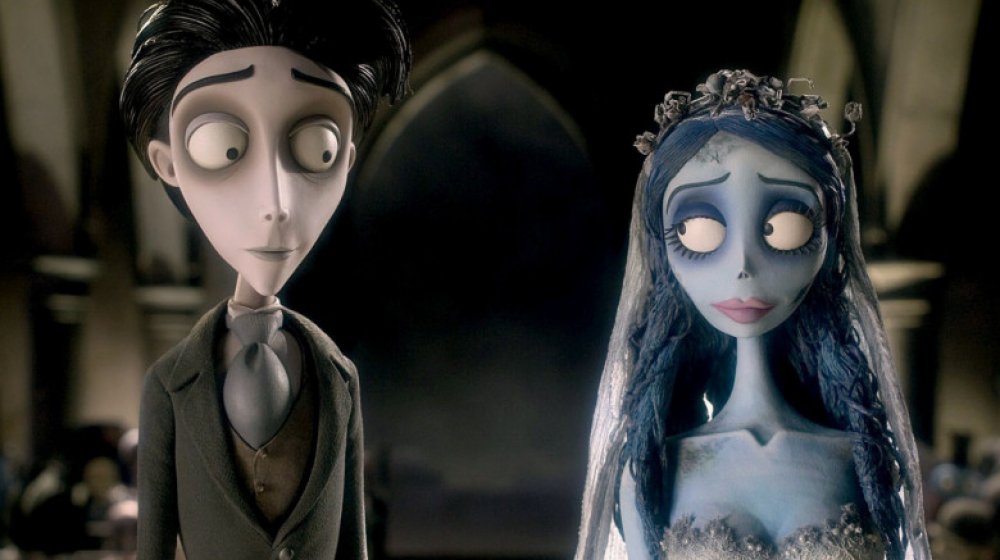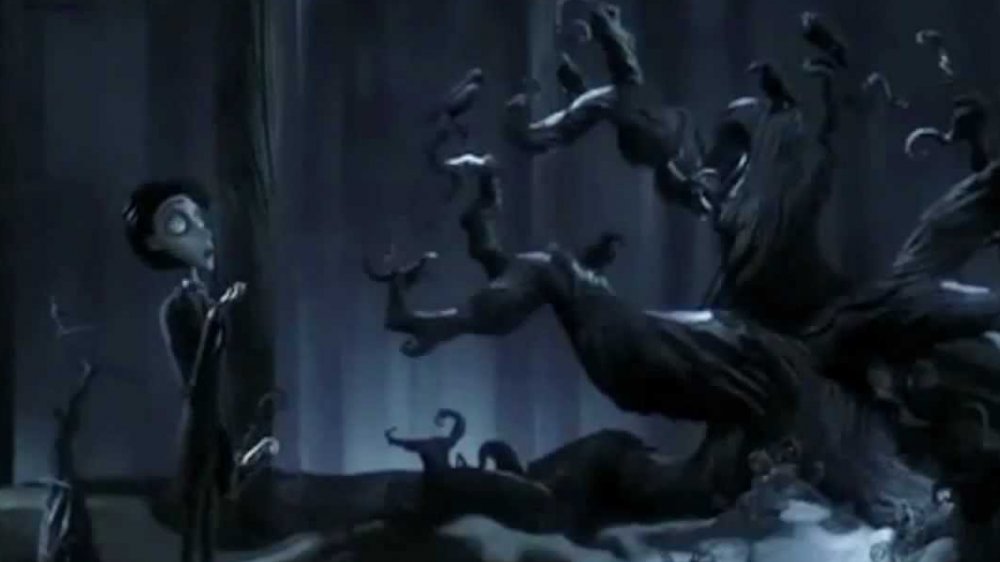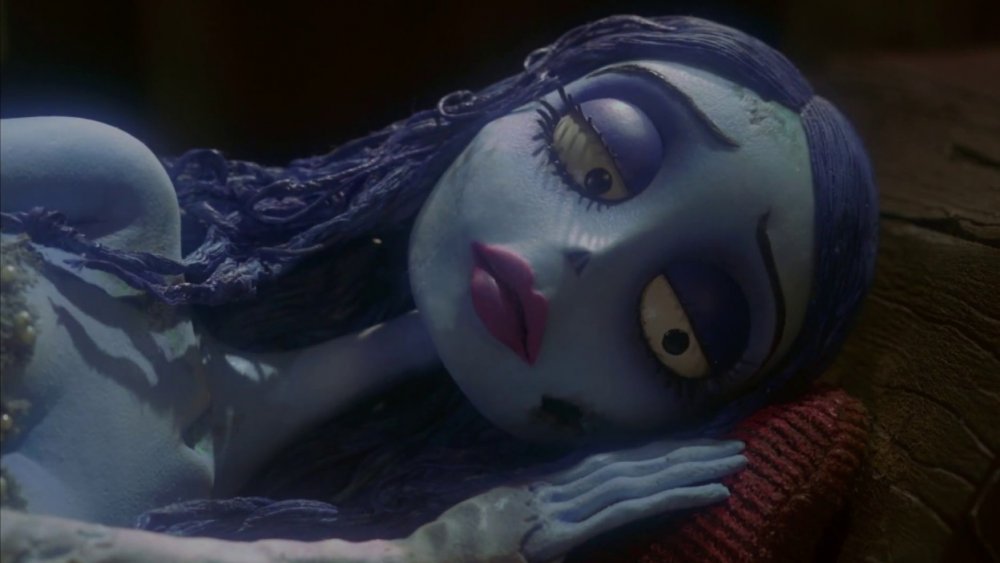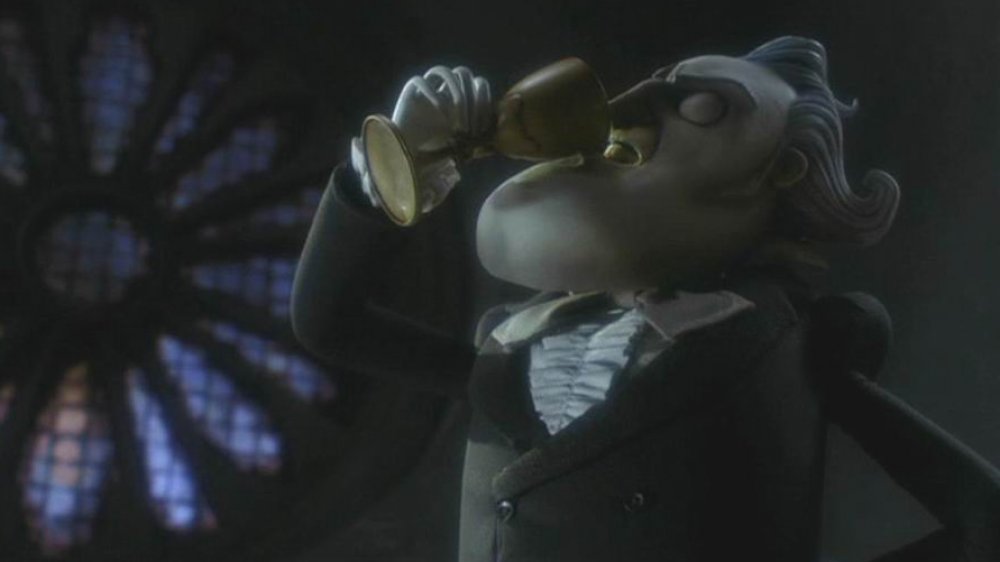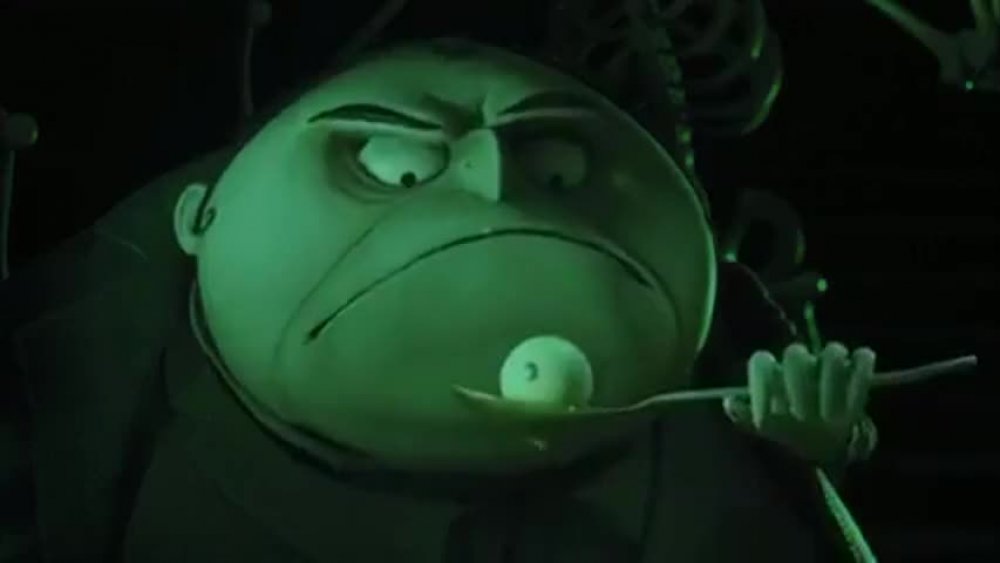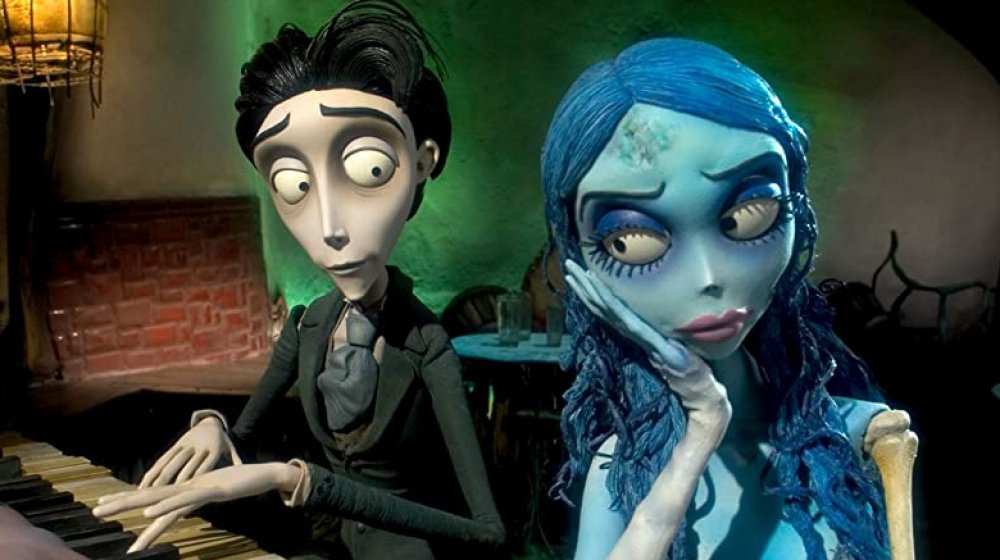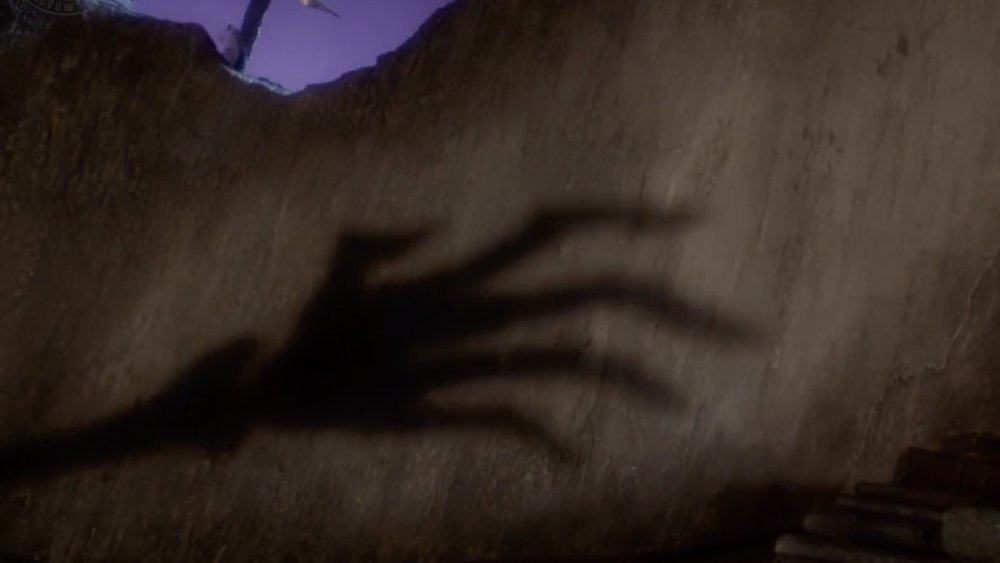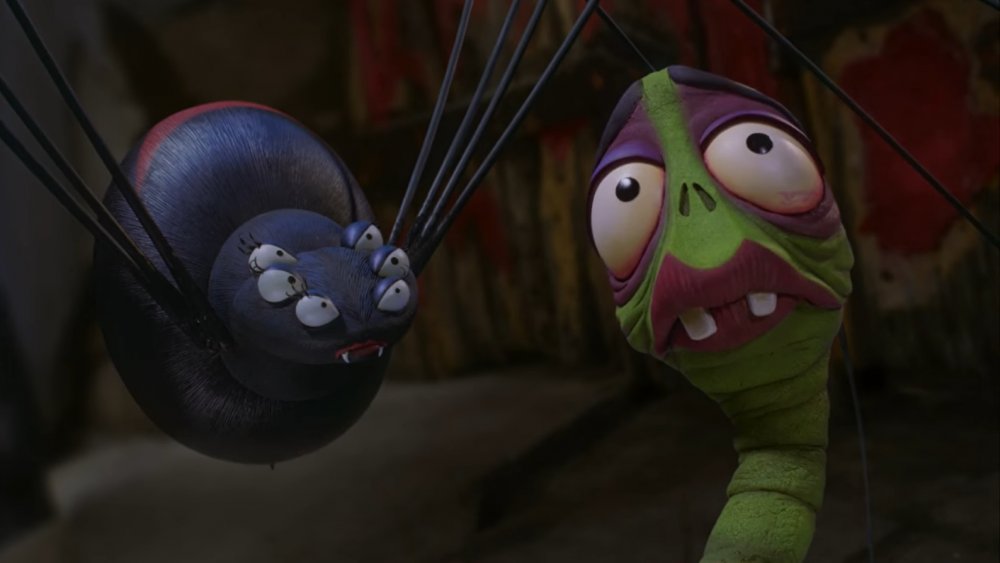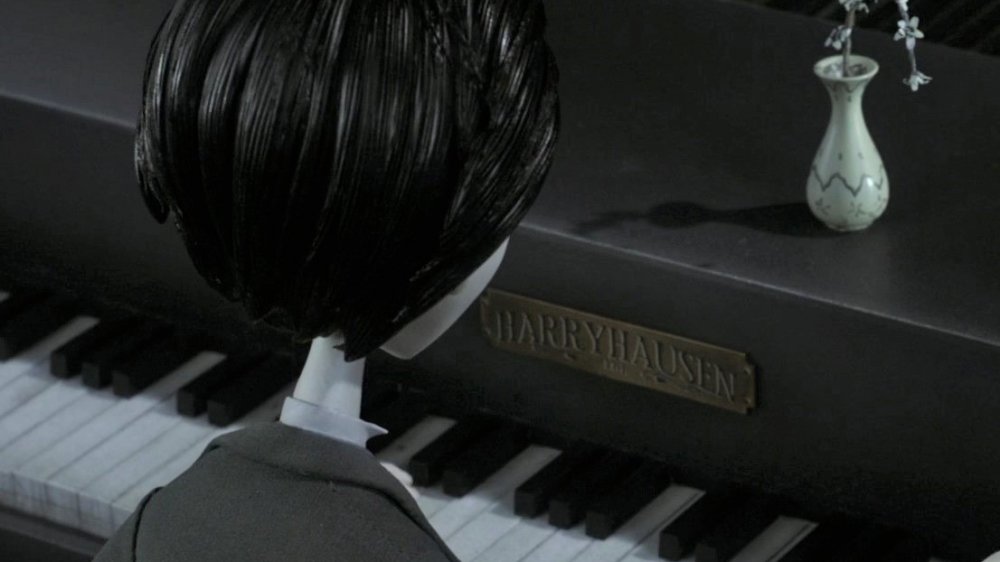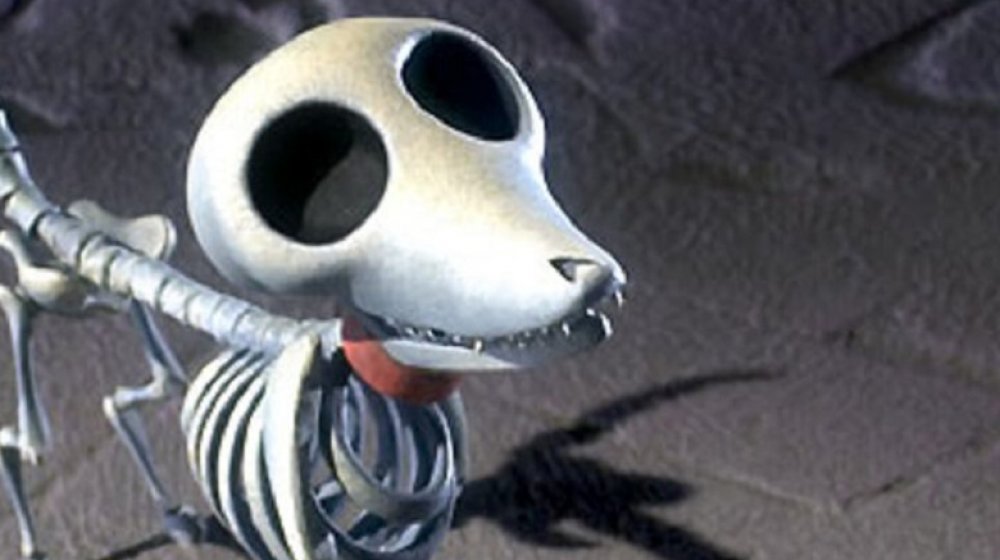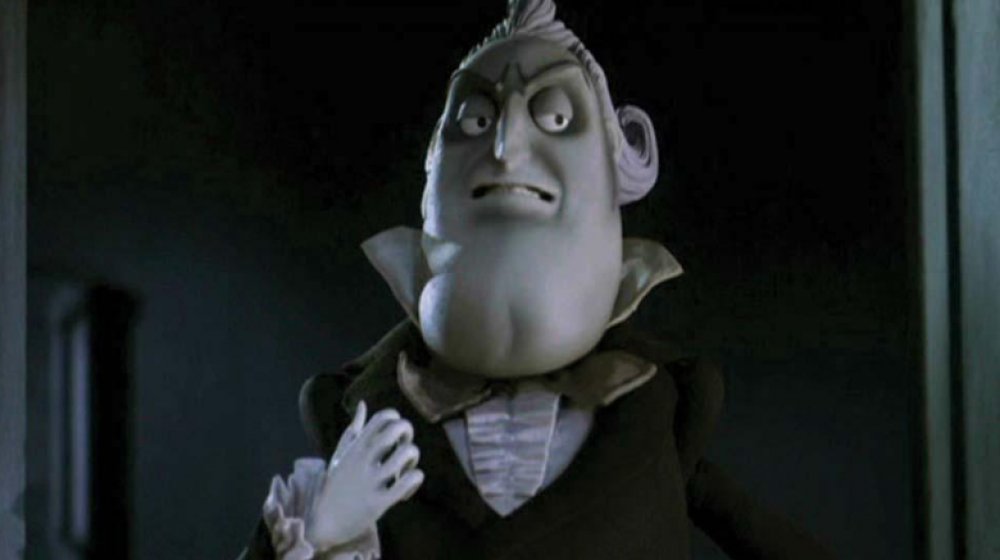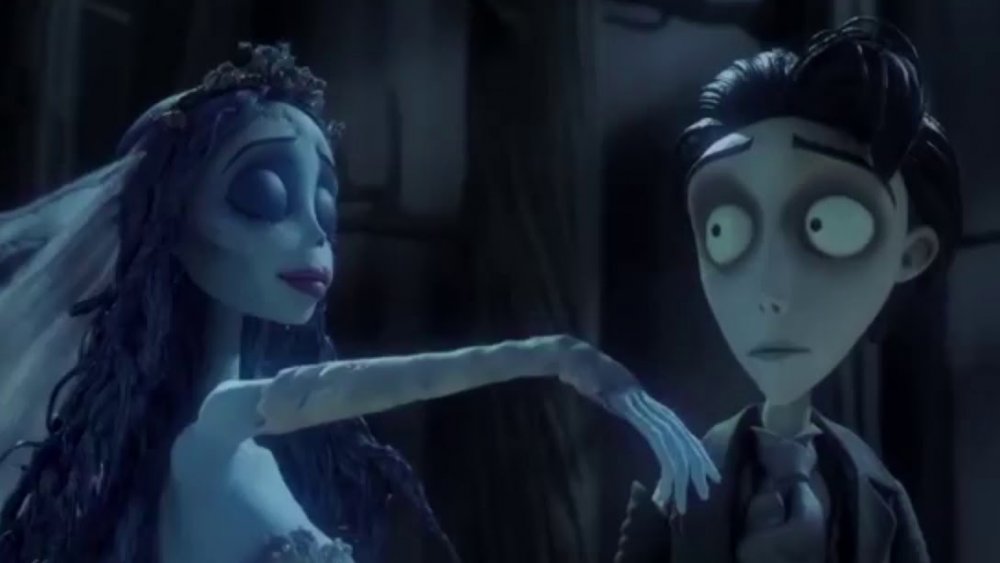Things Only Adults Notice In Corpse Bride
In addition to constructing dark, macabre, and surprisingly sensitive movies for adults — Ed Wood, Dark Shadows, Edward Scissorhands — Tim Burton has a second, parallel career as a craftsman of moody, spooky films made for kids and families. While the usual child-geared fare is bright, sunny, full of pop songs, and totally innocuous, Burton manages to express the surreal, frightening, curious elements of childhood without compromising on his depiction of how the world can be a scary place full of bad things and death.
Burton works especially well in the medium of stop-motion animation, as he did with the 2005 classic Corpse Bride. It's the folk tale-like story of the wrongfully murdered Emily (Helena Bonham Carter), drawn to the unsteady Victor (Johnny Depp), a well-to-do young man who's set to be married. But after a practice wedding proposal goes wrong, Victor finds himself caught up in an undead romance and lost in a strange world full of skeletons.
It's a film for kids with adult themes, and that extends to the subtext. There's plenty for children to enjoy in Corpse Bride, but there's also lots of material just for adults. Here are some treasures in Corpse Bride made for grown-up sensibilities only.
Corpse Bride gives us something to crow about
Corpse Bride is laced with clever, witty, humor of the wordplay variety, and on top of that, death features prominently in the plot — which tends to happen more often than not in the films of Tim Burton, the man responsible for other mortal coil-shedding works like Sweeney Todd, Beetlejuice, and Frankenweenie. But there's one running joke (or "flying joke," rather) buried in Corpse Bride that combines puns and death references, and it's so subtle and clever that even most adults wouldn't notice it on the first or second viewing.
The plot of Corpse Bride involves the premeditated murder of Emily, the titular corpse bride, at the hand of her evil fiancé, Lord Barkis Bittern (Richard E. Grant), who intends to kill again. Crows can be seen flying around and lingering throughout the movie, and it's not just because these sort of eerie, midnight-colored birds effectively add creepiness and moodiness to the proceedings. A grouping of crows is called a "murder," after all, which is a gag that ties nicely into the movie's macabre plot.
Upon close inspection, you'll discover the cause of death
There's a lot of death, murder, and attempted murder in Corpse Bride, although there isn't a lot of violence. Hey, this is a PG-rated movie for kids and families, after all, and depicting how the dead people get to be dead is largely inconsequential, as the events of the film are about how they're dealing with life after death (or not, as the case may be for certain zombie corpse brides). Still, the film does suggest how two of its deceased characters became permanent residents of the Land of the Dead and decaying.
The area's barber, entrusted with providing a haircut, retrieves his trusty scissors by pulling them out of his own head. This implies that the unlucky former entrepreneur was killed by the very tools of his trade, perhaps by someone extremely unhappy with the haircut he'd provided. As for Emily, the corpse bride herself, viewers know she was killed by the greedy and villainous Lord Barkis Bittern, but they aren't made privy as to how the act went down. Yes, he stabs her, but with what? Well, he probably used that sword he's always seen carrying around.
Brush up on your Shakespeare
The plays of William Shakespeare are more than 400 years old, but they represent the foundation of a lot of Western narrative fiction, be it theater, books, or movies. Plots laid out by the Bard recur throughout films, as do individual references to the works themselves. Shakespeare is so important and influential that screenwriters in the 21st century can include a nod and wide swaths of the audience will both get and appreciate the allusions.
But that's because most adults receive at least an overview of Shakespeare's "greatest hits" in a high school or college English literature class. Little kids watching a movie like Corpse Bride would likely have no clue when filmmakers launch and land a perfect reference to Shakespeare's most famous and epic tragedy Hamlet, which, like Corpse Bride, is full of foreboding actions and the promise of death to the tyrannical villains.
Toward the end of the movie, Lord Barkis Bittern tauntingly toasts Emily for her having died without marrying, and he takes a sip of poison, which had been intended for Victor to drink in order to join Emily in death. That's awfully reminiscent of the accidental poison switcheroo in Act V of Hamlet. The titular prince, intending to kill his murderous stepfather, Claudius, is toasted by his mother, Gertrude, with a glass of wine that Claudius had poisoned and intended to give to Hamlet.
Corpse Bride is a very punny movie
For a movie about dead people, Corpse Bride has a surprisingly light touch, particularly in its dialogue. The script is bright, bouncy, and agile, and along those lines, it's full of groan-inducing puns and old jokes that any goofy dad would proudly steal and make his own. For example, in the Land of the Dead, Victor meets a short, zombified skeleton dressed in late 18th-century military officer regalia, replete with a bicorn hat and a sword. He's instantly recognizable to adults as a riff on French general and European conqueror Napoleon Bonaparte, a bit made overwhelmingly clear when his name is revealed to be General Bonesapart — you know, because he's a skeleton, and skeletons are made of bones.
Later, the dead descend on stern Finis Everglot (Albert Finney). In that group is Bonejangles (Danny Elfman), his mission interrupted when his eyeball pops out of its cranial socket and into the brothy bowl that sits in front of Finis. He then remarks, "There's an eye in me soup." That's a reference to the nearly ancient joke (and its many variations) of a displeased restaurant patron reporting to the waiter about a fly in their soup. And then there's the corpse bride, a woman dealing with the loss of flesh, rapid decay, and death itself. She literally isn't in the best physical shape, which is why she's said to have "a wonderful personality," an old euphemism used to talk up people who aren't, on the whole, objectively physically attractive.
Watch your language, Corpse Bride
It seems like the people who make movies that are ostensibly for kids and clearly marketed to the young ones like to throw in mildly risqué jokes. Not only are these little verbal Easter eggs so subtle and specific that children will have no idea anything untoward was said, but they feel like a little reward to adults or parents who dutifully sat through a movie made for children.
Corpse Bride has a few examples of innuendo and suggestive dialogue, and some of it is particularly tough for kids to notice because it's somewhat era-appropriate to the film's Victorian sensibility. For example, the Everglots look down their noses at Victor Van Dort and his family because, although they're wealthy, their money comes from running a canned fish empire. They dismissively call the Van Dorts "fish merchants," and even though that's what they actually are, it's implied that it's not a respectable profession — particularly because a few hundred years ago, "fishmonger" was a euphemism for "procurer," or a man who manages female sex workers.
On another occasion, Victor goes right up to the edge of making a sexually suggestive gesture. While practicing his upcoming wedding vows alone in the forest, he recites, "With this hand, I will cup your ..." and notices that he's formed a cupping gesture in front of his own chest. He's mildly aghast with this mimed, imaginary groping.
There are some really old movie references
By the time they get to be the age where they're old enough to have kids with whom they can watch family films like Corpse Bride, adults have also absorbed volumes of cultural history. Just by living for a few decades and consuming mass quantities of mass media, most grown-ups have unofficially attended film school, and they can recognize references and allusions to older, classic movies placed in the newer works of modern filmmakers who are unabashedly cinema devotees, such as Corpse Bride director Tim Burton. This stop-motion animated film from 2005 is rife with nods to movies as far back as the 1920s and 1930s — references the average child, relatively new to movie consumption, probably wouldn't be able to spot.
In a scene in the lair of Elder Gutknecht (Michael Gough), the character's arm passes by a candlelit wall. It comprises only about a second of screen time, but it's enough to evoke a famous shot from the pioneering 1922 vampire movie Nosferatu. Then in the big musical number "Remains of the Day," the dancing skeletons dance similarly to how the skeletons dance in the spooky 1929 Disney short "The Skeleton Dance." Burton also pays homage to his horror master predecessor, Alfred Hitchcock. The group of crows that look down on Vincent recalls the shot of the birds looking down on Tippi Hedren's character in The Birds.
The stars came out for Corpse Bride
Corpse Bride often alludes to the stars of some of Hollywood's most classic films. For example, Alfred is an elegant and cultured skeleton, a denizen of the Land of the Dead who strikes quite the handsome figure in his purple jacket and long, thin mustache. His wife, Gertrude, comments that he's "been dead for 15 years," to which he replies, "Frankly my dear, I don't give a damn." That's a reference to the famous kiss-off line from the 1939 classic Gone With the Wind, uttered to Scarlett O'Hara (Vivien Leigh) by her former love, Rhett Butler (Clark Gable), a character who, like Alfred, favored vibrantly colored suit coats.
One major character in Corpse Bride is a full-on imitation of another movie star of Hollywood's Golden Age, although one who's been relatively forgotten by the 21st century and certainly not someone who kids and toddlers would be familiar with. A maggot, known only as Maggot, lives inside of the rotting but living corpse of Emily. Their relationship is symbiotic in that he presumably lives off her dead flesh but also offers her friendship and guidance. Maggot is voiced by Enn Reitel, who delivers a convincing vocal impersonation of actor Peter Lorre, co-star of classics like M, The Maltese Falcon, and Casablanca, and whom Maggot even resembles.
Everybody loves Ray Harryhausen
Corpse Bride is an animated movie, but unlike traditional, hand-drawn Disney movies or the computer-enabled, ultra-realistic Pixar style, it was produced via the deliberate and extremely taxing method of stop-motion animation. To greatly simplify, the process involves a staff of animators contracting actual physical models of a film's characters, props, and settings, and then manipulating them just so, taking a picture, and so on, creating the illusion of movement (or animation).
Stop-motion animation is how the California Raisins and Wallace and Gromit came to life, and the technique was pioneered by special effects artist Ray Harryhausen, who used the style to bring to life creatures in pre-CGI sci-fi and fantasy films, such as 1963's Jason and the Argonauts and 1966's One Million Years B.C. In fact, Corpse Bride would never have been possible without the work of Harryhausen, and its filmmakers decided to pay tribute. In the scene where Victor Van Dort sits down to play the piano, he does so on an instrument purportedly made by "Harryhausen."
Here's to you, Tim Burton
Sure, Tim Burton and his filmmaking cronies who brought Corpse Bride to life reference and pay tribute to a number of old movies, old movie stars, and legendary filmmakers of yore, but they also throw in a few shout-outs to projects that hit closer to home and from the not-so-distant past. Specifically, there are a few allusions, both quiet and unmistakable, to the films of Tim Burton, which adult audiences might be more likely to notice than kids would.
At the outset of the film, the corpse bride is dead and buried, her not-quite-final resting place under a large and imposing tree. That tree closely resembles the same tree under which the Headless Horseman is temporarily buried in Burton's 1998 movie Sleepy Hollow. Another Corpse Bride element that looks familiar? The character of Victor Van Dort. Finis Everglot mistakenly (and carelessly) calls Victor by the name Vincent, so perhaps he saw Tim Burton's early short film "Vincent," with a title character who bears a resemblance to Victor.
Overall, Corpse Bride concerns dead people taking extreme action against living beings, which is more or less the plot of Burton's 1988 film Beetlejuice. Nor is Corpse Bride the first Burton project to feature a zombie dog. His 1984 short film "Frankenweenie" and the 2012 full-length animated remake of the same name are both about a dead dog come back to life, much like how Victor is reunited with his beloved, lost pet Scraps in Corpse Bride.
Lord Barkin Bittern didn't do his due dilligence
An adult mindset brings a different perspective to a film than that of a child. Not only does life experience and a deeper cultural knowledge offer another point of view, as well as the ability to notice movie references or Easter eggs, but the intelligence learned just by spending more time on the planet allows adults to notice plot holes or character inconsistencies that would likely not bother a child audience member one bit. In Corpse Bride, such a problem exists in the motivations of the film's primary villain, the loathsome Lord Barkis Bittern. He's the former fiancé of the deceased Emily, having killed her and robbed her of her wealth. That becomes his modus operandi — to convince women to marry him, stealing their treasures, then killing them.
Making things complicated, Victoria's (Emily Watson) parents prefer the dashing, old, presumably moneyed Bittern to Victor, and they decide to marry off their daughter to him instead of Victor (when Victor absconds with the undead Emily against his will). This is mostly according to Bittern's plan. He wants the Everglots to allow him to marry Victoria so that he can cash in on the dowry and then murder Victoria thereafter. However, the Everglots are actually broke, and they thought they were the ones going into the marriage for financial gain. But if Bittern's grand plan is to marry for money, wouldn't he have properly researched beforehand if the Everglots were, in fact, wealthy?
There are some familiar Burton players in the mix
Tim Burton is one of those filmmakers who likes to work with the same actors over and over again. A spirit of collaboration and a shared storytelling language emerges when directors and performers make several movies together, leading to a definitive moviemaking style. Corpse Bride, both dark and sweet, certainly feels like a film made by the man who also directed Edward Scissorhands and produced The Nightmare Before Christmas, and that could be due to his enlisting several of his most frequent compatriots, actors who older viewers could very well recognize on voice alone.
Johnny Depp leads the cast as Victor Van Dort, having been directed by Burton previously in Edward Scissorhands, Ed Wood, Sleepy Hollow, and Charlie and the Chocolate Factory. Helena Bonham Carter portrays Emily, and she'd worked with Burton in Big Fish and Planet of the Apes. The late Michael Gough (Elder Gutknecht) played butler Alfred Pennyworth in Burton's Batman films, while his composer of choice, Danny Elfman, portrays skeleton Bonejangles, the spiritual cousin of Jack Skellington, who Elfman voiced in The Nightmare Before Christmas. Deep Roy co-starred in two 2005 Burton films — in Corpse Bride as General Bonesapart and the Oompa Loompas in Charlie and the Chocolate Factory — and Albert Finney followed his role in Burton's 2004 drama Big Fish by voicing Finis Everglot.
